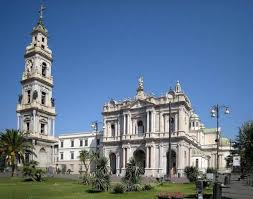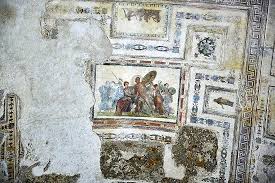
“MODERN” POMPEII MASTERPIECE DISCOVERED
There is more to Pompeii than the excavated city dug out of the disaster of the long ago eruption of Vesuvius. Pompeii is also a modern city, part of the “Metropolitan City of Naples” and with over 23,000 inhabitants. It is also a major religious destination drawing 4 million Roman Catholic pilgrims every year to the celebrated shrine of the Beata Vergine Maria del Santo Rosario di Pompei (the Blessed Virgin Mary of the Holy Rosary of Pompeii).
It now has an additional attraction for art lovers, with the recent surprise discovery of a long-lost Andrea Mantegna masterpiece of the “Deposition of Christ.” The painting, which was very badly damaged, was barely recognizable when it came to light stacked in an obscure corner of the church, where, for unknown reasons, it had been trasferred from the Basilica of San Domenico in Naples and forgotten.
The painting is now in the Vatican Museum, where it is being cleaned and restored by experts. It will be on public view for the next few months before it is returned to its “adopted” home in the Pompeii sanctuary, where it will be permantently exhibited in a special room along with 12 other paintings of the Neapolitan School of the 17th and 18th centuries.
Info: Tel. +39.081.8577371 www.santuario.it

FAI REOPENS THEATRE OF VERDURE
The Annual spring weekend (21st-23rd April 2025) of FAI (Fondo Ambiente Italiano – Italian Heritage Foundation), the Italian branch of the International National Trusts Organization for heritage preservation, offered the customary opportunities for art and culture lovers to visit many special protected cultural sites not normally available to the public.
Among those was the rarely open 18th century Villa d'Ayala Valva near Salerno (Campania), a 44 acre estate, that has been dubbed the “Versailles of Campania” due to its magnificent Italian gardens. The villa was gifted to the Knights of Malta by the last remaining heir of the D'Ayala Valva dynasty.
One of its most fascinating features is the Teatro di Verzura (Theatre of Verdure), an open air auditorium immersed in Nature and largely covered in shrubs and plants and decorated with sculptures and fountains, which was used for summer performances to entertain the marquise's guests.
These little known outdoor theatres were once a frequent feature in the gardens of noble families. 18 of these are listed in Italy as having survived. The oldest in Europe is believed to be the 17th century Royal Villa of Marlia in Tuscany, treasured and restructured by Napoleon's sister, Elisa Bonaparte Bacliocchi, while she was Grand Duchess of Tuscany.
The 2025 FAI Spring Weekend saw the exceptional opening to the public of 750 sites, many of which are normally closed to the public.
Info: www.fondoambiente.it

EASTER SKY OF KITES AT CERVIA
Indonesian artist, sculptor and kite master Kadek Armika is the guest of honour at this year's Artevento spring festival in Cervia (Emilia Romagna) where his works will be on show under the title “Balance and Harmony” in the Magazzino del Sale (the former Salt Warehouse) exhibition centre. The show previews the spectacular sight of hundreds of kites, flown by kite designers and enthusiasts from all over the world during the annual Artevento Cervia festival that runs for the entire period of the spring holiday (19 April – 4 May 2025).
The event takes on a special meaning this year as it celebrates its 45th edition and focusses on the theme of a message of peace.
The town of Cervia on the Po Delta, has been celebrated for hundreds of years for its naturally pure salt production, appreciated not only in gastronomy but also in beauty treatments and known as “the White Gold of the Adriatic.” Cervia sits on a vast park of over 2,000 acres containing 50 lagoons, woodlands and a 16 km-long canal. The Cervia Park is a recognized ecological centre for wetland conservation and wild life. Organized boat trips are available to view rare birds like flamingos, black-winged stilt birds and great egrets.
Info: Tel. +39.051.6569105 info@culturaliart.com https://artevento.com

TUSCANY'S OCTOPUS HAVEN
The Gulf of Talamone at Orbetello (Tuscany) is the site chosen for the first Italian octopus protected area. The project, set up by a team of scientists and environmentalists operates under the name OCTOPOLIS in collaboration with the Science and Environmental Department of the University of Siena, aims to create safe “houses” for an octopus colony in specially designed clay pots which rest on the seabed and cannot be caught up in fishermen's nets.
Octopuses are constantly caught in drag fishing nets and killed. Global warming of the Mediterranean has also seriously depleted their numbers, due to changes in the marine ecosystem and pollution. The Octopolis project also aims to make the public more aware of the unique qualities of these fascinating marine creatures which have highly developed brains that allow them to solve problems and interact with each other.
The Casa dei Pesce (House of Fish), a non-profit association, founded in 2012 to monitor marine life in the Mediterranean is also involved. Inspired by local activist Paolo Fanciulli, better known as “Paolo il Pescatore”,(Paolo the Fisherman), who stopped illegal drag net fishing in the Orbetello coastal waters by submerging large stone blocks on the seabed. Soon local sculptors began to donate their works to the cause, thus creating an underwater museum with 44 art works, that can be admired by divers.
The Octopolis Project has set up a crowdfunding appeal to help finance further research.
M. STENHOUSE
Info: Tel. +39. 3444071412 https://casadeipesci.it info@casadeipesci.it

TURIN'S NEW CHOCOLATE MUSEUM
Just over a year ago, Turin (Piedmont) opened its first Chocolate Museum, joining the Choco-Story brand venues already present in Paris, Brugge, Brussels and Prague. The museum is situated in the historic Pfatisch confectioner's shop and laboratory, celebrated for over a century for its chocolate creations and offers a fascinating overview of chocolate production from the earliest times to the present.
The city of Turin, however, has been linked to chocolate production since 1560, when the Savoy royal family introduced the fashion of drinking hot chocolate. iSince then, Turin's chocolate producers have developed treats that are household names, like Gianduiotta, Boero, Cremino and the world's favourite chocolate spread – Nutella.
Every year, the city hosts ChoccolaTo, the great international Chocolate Fair. This year's edition ended on the 2nd March, and attracted thousands of chocolate-makers and visitors.
The chocolate theme has also become a major tourism pull, with “sweet” tours to visit the many traditional chocolatiers in the city and watch how they make their gastronomic treats.
-
Stenhouse
Tel: 0039.011.19820447 info@choco-story-torino.it

PAPYRUS SECRETS REVEALED
Lovers of ancient history and antiquities are all agog to see the results of the new techniques developed to read the charred fragments of the papyrus scrolls discovered in the ruins of the city of Herculaneum (near Naples) during the first excavation campaign in the 18th century.
Herculaneum, together with the nearby city of Pompeii, was destroyed in the volcanic eruption of Vesuvius in 79 AD.
Over 1,800 carbonized scrolls were unearthed at a depth of 37m under layers of volcanic rock.
Most, however, have been destroyed or badly damaged in attempts to open them. However, ultra modern scanning techniques are beginning to penetrate the secrets of the remaining fragments.
Mostly they contain philosophical texts by Ancient Greek authors, but last year Graziano Ranocchio, a researcher at the University of Pisa, found something different...... indications of Plato's hitherto unknown burial place, which was apparently situated in a garden dedicated to him by the Platonic School near the Mouseion (Hill of the Muses), near the Acropolis of Athens. The Italian National Research Council (CNR) has been woking closely on the analysis of the papyrus scrolls along with other important research institutes, including the University of Oxford (UK)
Further surprises and revelations are expected to follow........
Info: https:ps//www.cnr.it

PRATO'S SILK MASTERPIECES
A feast for the senses: throughout 2025 the Textile Museum of Prato (Tuscany) is running a special exhibition entitled “Treasures of Silk” that traces the development of Italian luxury woven materials, dating from the Renaissance to the 20th century.
The exhibition is centred round the collections of two eminent donors. For the first time, the recent endowment of over 2000 items that belonged to Florentine doctor Giovanni Falletti is on display, along with that of entrepreneur and art collector Loriano Bertini (1930-2019), which formed the first nucleus of the museum's own collection.
The exhibition offers visitors a unique view of sumptuous patterned silk materials woven over five centuries to create the elaborate clothes of Italian and European royalty, notables and church dignitaries.
Of special interest are the exhibits of textile designs created by modern artists such as the Uk sculptor Henry Moore (donated by the artist) as well as Italian architect and designer Giò Ponti, contemporary designer Bruno Munari, sculptor and printmaker Giò Pomodoro, Futurist artist Thayaht and the French painter Raoul Dufy.
There are also historic curiosities like fragments of tapestry from Egypt from the 4th century AD, and a camel wool fringe belonging to the Nazca culture from Peru, as well as masks and Japanese prints and rare 18th century examples of 18th century embroidery.
The Museum is housed in the former Cimatoria Campolmi factory where die-cutting operations were carried out. This was converted into a museum in 1997.
“Treasures of Silk” exhibition runs until 21st December 2025.
Info: Tel. +39.0574.611503 www.museodeltessuto.it info@museodeltessute.it

VENICE'S NEW GARDEN
Venice, the city of water, is notoriously short of gardens and parks. However, there are green spaces all over the city, many tucked away behind noble palaces and churches and specialized walking tours are available that reveal surprising hidden gems.
A few months ago, the Orto Giardino del Redentore (Garden Orchard of the Church of the Most Holy Redeemer) opened to the public after an extensive restoration and restyling project carried out by Adele Re Rebaudengo, founder and president of the Venice Garden Foundation.
The 2.50 acre garden is part of the territory of the historic Capuchin monastery of the Church of the Most Holy Redeemer, situated on the Giudecca Island. The restoration of the monks' garden involved planting over 2,500 trees and plants, including olive trees, cypresses, various fruit trees and the installation of a 400m pergola covered in grapes, roses and wisteria. Also included in the restoration project were the ancient Chapel and the Library building.
The garden also contains a water lily pond, a well designed to gather and store rain water collected from the roofs of the buildings and an area with bee hives.
Info: Tel. +39.041.3121700 www.venicegardensfoundation.it

CARNIVAL BATTLE OF THE BEANS
The Carnival season, held all over Italy with many local variations, includes a focus on typical regional foods, and winter staples like beans feature prominently in many areas. The small town of Santhìa (Piedmont) claims to stage the oldest annual Carnevale bean cook-up in Piedmont, dating from the 17th century.
This year the traditional bean feast involves 20,000 portions of beans bubbling in copper cauldrons set out in a line along the town centre.
However, Santhìa has a rival. Chiavazza, a hamlet on the fringe of Biella (Piedmont) at the foot of the Alps, cooks a hundred pans of beans for the Carnevale annual feast. Although the tradition is relatively new, (dating from the early 19th century), it managed to get a nomination in the Guinness Book of Records in 2022.
This did not go down well with Santhìa which tries each year to upstage its rival. This year, however, Chiavazza has a new trick up its sleeve . It is offering “chocolate beans” as a crowd puller. This has nothing to do with the dragèe chocolate sweets that supermarkets and confectioners sell. Instead, the secret recipe launched by Chiavazza involves adding Ecuador bitter cocoa powder to the beans' cooking water. Organizers claim that this addition adds greatly to the flavour and makes the cooked beans more digestible
Info: https://prolocosanthia.it https://www.comune.biella.it

THE COLOURS OF THE GOLDEN HOUSE
During recent excavations under the pavement of the Domus Aurea in Rome (the Emperor Nero's “Golden House”), archeologists found a cache of containers with pigments to create the colours that would have been used by artists like Famulus (also called Fabullus), the most important artist of Imperial Rome, and his assistants. Traces of their work are still visible on the walls of some of the rooms in the palace that Nero built as his private residence and which may have been one of the contributing factors of his downfall. After the fire that destroyed much of the city, malicious rumours went around that the emperor had allowed the fire to spread deliberately in order to clear more space for his palace and park.
The pigment tanks contained traces of realgar (ruby sulphur or arsenic sulphide), a mineral used to produce tones of red. The most exciting find, however, was an exceptionally large ingot of “Egyptian Blue” weighing 2.4 kgs. This pigment, used in art since the early Bronze Age in Egypt and Mesopotamia, is a man-made compound of silicone, limestone, copper and carbonate of soda, widely used in frescos and other decorative work. Expensive and considered precious, it is usually found in much small fragments or in powdered form.
Info: Tel.+39.06.3996.7700/6998443 https://cultura.gov.it>
<< Previous 1 2 3 4 5 6 7 8 9 10 11 ... 13 ... 15 ... 17 ... 19 ... 21 ... 23 ... 25 ... 27 ... 29 ... 31 ... 33 ... 35 ... 37 ... 39 ... 41 ... 43 ... 45 ... 47 ... 49 ... 51 ... 53 ... 55 ... 57 ... 59 ... 61 ... 63 ... 65 ... 67 ... 69 ... 71 ... 73 ... 75 ... 77 ... 79 ... 81 ... 83 ... 85 ... 87 ... 89 ... 91 ... 93 ... 95 ... 97 ... 99 ... 101 ... 103 ... 105 ... 107 ... 109 ... 111 ... 113 ... 115 ... 117 ... 119 ... 121 ... 123 ... 125 ... 127 ... 129 ... 131 ... 133 ... 135 ... 137 ... 139 ... 141 ... 143 ... 145 ... 147 ... 149 ... 151 ... 153 Next >>



